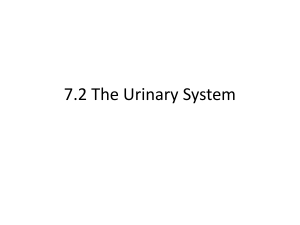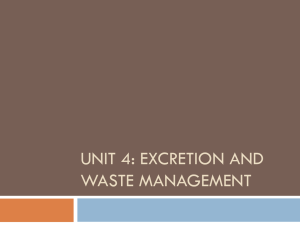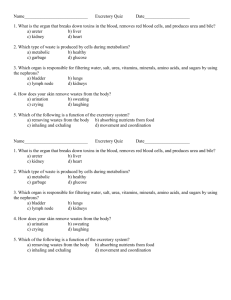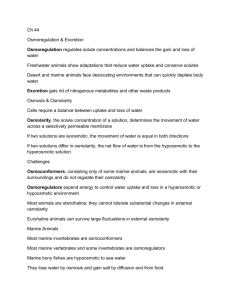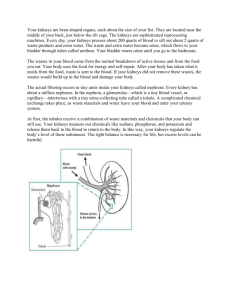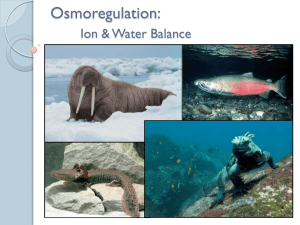EXCRETION It is the process of removing the waste products of
advertisement
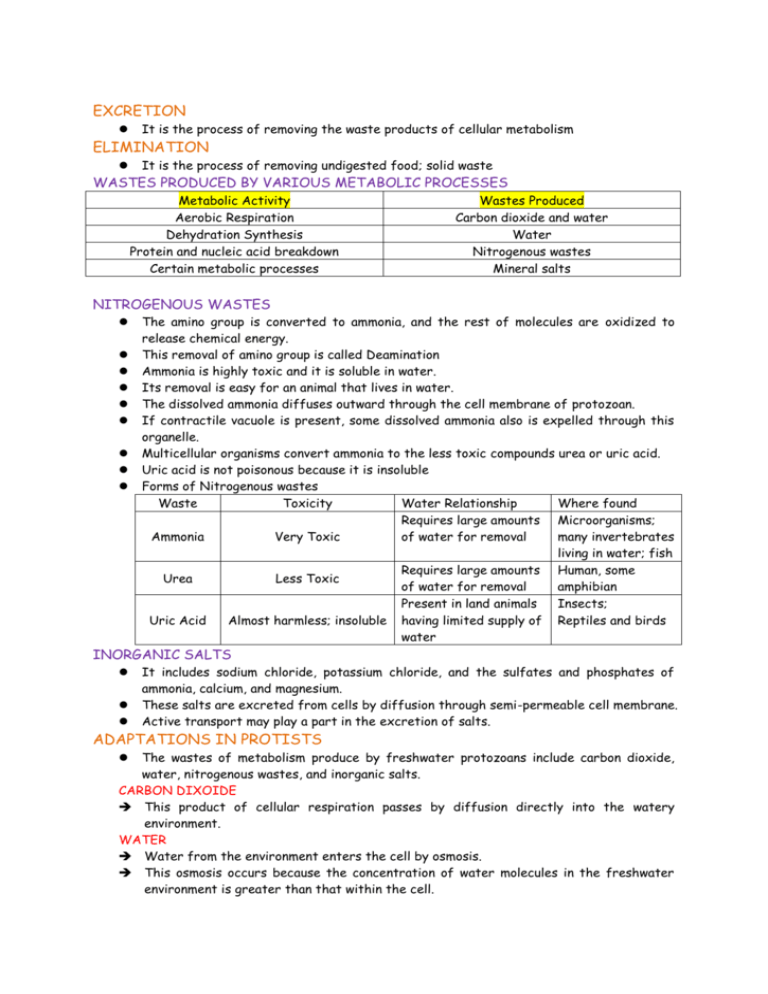
EXCRETION It is the process of removing the waste products of cellular metabolism ELIMINATION It is the process of removing undigested food; solid waste WASTES PRODUCED BY VARIOUS METABOLIC PROCESSES Metabolic Activity Aerobic Respiration Dehydration Synthesis Protein and nucleic acid breakdown Certain metabolic processes Wastes Produced Carbon dioxide and water Water Nitrogenous wastes Mineral salts NITROGENOUS WASTES The amino group is converted to ammonia, and the rest of molecules are oxidized to release chemical energy. This removal of amino group is called Deamination Ammonia is highly toxic and it is soluble in water. Its removal is easy for an animal that lives in water. The dissolved ammonia diffuses outward through the cell membrane of protozoan. If contractile vacuole is present, some dissolved ammonia also is expelled through this organelle. Multicellular organisms convert ammonia to the less toxic compounds urea or uric acid. Uric acid is not poisonous because it is insoluble Forms of Nitrogenous wastes Waste Toxicity Water Relationship Where found Requires large amounts Microorganisms; Ammonia Very Toxic of water for removal many invertebrates living in water; fish Requires large amounts Human, some Urea Less Toxic of water for removal amphibian Present in land animals Insects; Uric Acid Almost harmless; insoluble having limited supply of Reptiles and birds water INORGANIC SALTS It includes sodium chloride, potassium chloride, and the sulfates and phosphates of ammonia, calcium, and magnesium. These salts are excreted from cells by diffusion through semi-permeable cell membrane. Active transport may play a part in the excretion of salts. ADAPTATIONS IN PROTISTS The wastes of metabolism produce by freshwater protozoans include carbon dioxide, water, nitrogenous wastes, and inorganic salts. CARBON DIXOIDE This product of cellular respiration passes by diffusion directly into the watery environment. WATER Water from the environment enters the cell by osmosis. This osmosis occurs because the concentration of water molecules in the freshwater environment is greater than that within the cell. EXCRETION IN PROTOZOA Waste How Formed Carbon Dioxide Cellular respiration Water Cellular respiration Dehydration synthesis Nitrogenous Removal of NH2 groups from waste excess amino acids to ammonia DEAMINATION Inorganic salts General metabolism How excreted Diffusion through cell membrane Osmosis; contractile vacuole Active transport Unicellular organisms remove ammonia dissolved in much water, by diffusion. Diffusion ADAPTATIONS IN ANIMALS HYDRA Its cells are in contact either with the external water or with the water present in the digestive sac. Hydra excretes excess water by active transport. Hydra LACKS Contractile Vacuole Hydra excretes nitrogenous waste in form of ammonia. The ammonia diffuses through the cell membrane. EARTHWORM Most of its cells are not in contact with the external environment. Special excretory organs are used for removal of wastes. Excretory organ is known as nephridia. Nephridia are pairs of tubes that are found in most of the body segments. They carry wastes from the fluid of the body cavity to pores in the body wall. Water serves as a solvent for the nitrogenous wastes (ammonia and urea) and for the mineral salts that are excretes through the nephridia. Carbon dioxide diffuses from the blood stream through the moist skin to the outside terrestrial environment. GRASSHOPPER It lives in a dry environment, It cannot afford to use water in dissolving and excreting ammonia or urea. Grasshopper excretes nitrogenous waste in the form of insoluble crystals of uric acid. The specialized structures for excretion in the grasshopper are the Malpighian tubules. These tubules pick up nitrogenous wastes, mineral salts, and water. Most is reabsorbed back into the blood. Most of the carbon dioxide passes by diffusion from the grasshopper’s cells into the tracheal tubes which carry it to the atmosphere by way of the spiracles. HUMAN Excretory organs of humans are the liver, kidneys, lungs, and skin. Kidneys have millions of tube like structures called nephrons. Nephrons remove water, salt, and urea from the blood that passes through the kidneys. Water is excreted in air exhaled by the lungs, in sweat given off by sweat glands in the skin, and in urine excreted by the kidneys. Nitrogenous waste is given off largely in form of urea which is present in urine and sweat. Carbon dioxide is removed from the blood as it passes hrough the lungs and is expelled into the atmosphere. Waste Structure for removal Protozoa Hydra Ammonia Ammonia Cell membrane Contractile vacuole Cell membrane Earthworm Urea Ammonia Paired nephridia Grasshopper Uric Acid (solid) Malpighian tubules intestine Human Urea Uric Acid Nephrons of Kidney EXCRETION IN HUMANS THE URINARY SYSTEM – the human urinary system consists of kidneys, ureters, urinary bladder, and urethra. KIDNEYS Two bean-shaped, fist-sized organs. A large portion of blood enters the two renal arteries that lead to the kidneys. HIGH PRESSURE Blood that has delivered wastes to the kidneys returns by renal veins to circulation. LOW PRESSURE Wastes removed from the blood are excreted from the kidneys in the form of urine. NEPHRONS It is the functional unit of the kidneys The nephron tube begins with a bulb-shaped body at one end, the Bowman’s capsule. A branch of the renal artery enters into the Bowman’s capsule, branches to form a dense ball of capillaries called the glomerulus, and then exits the capsule. The convoluted tubule is a winding tube that begins with the proximal convoluted tubule at the Bowman’s capsule and ends with the distal convoluted tubule where it joins with the collecting duct. The middle of the tubule, called the loop of Henle, is shaped like a hairpin and consists of a descending and ascending limb. Surrounding the tubule is a dense network of capillaries that originate from branches of the efferent arteriole that exited the glomerulus. The distal convoluted tube empties into the collecting duct which descends in the same direction as the descending limb toward the center of the kidney. A single collecting duct is shared by numerous nephrons and empties into renal pelvis, which, in turn, drains into the ureter. FORMATION OF URINE FILTRATION Materials diffuse from the blood capillaries of the glomerulus into Bowman’s capsule. The diffusion is cause by the high blood pressure in the arteries that supply the capillaries. Diffusing into the capsule are water, glucose, amino acids, salts, and urea. Not diffusing, but remaining in the blood are the blood cells and most of the proteins. REABSORPTION The filtrate passing into the Bowman’s capsule contains digested food materials needed by all the cells of the body. Also contains large amounts of water. As filtrate passes along the coiled tubules and the loop of Henle, much of its content is reabsorbed into the capillaries that surround this region of nephron. Water passes back into the blood by osmosis, but glucose and amino acids move from the cells of the tubule by active transport. When the filtrate drains into the renal pelvis, it is concentrated urine. SECRETION The cells lining the tubule secrete some substances from the blood into the tubule. This movement is opposite of reabsorption. Urine contains water, urea, uric acid, salts, some hormones, breakdown products of hemoglobin, and other organic materials. OTHER ORGANS FOR EXCRETION LUNGS Carbon dioxide and water, produced in the cells by aerobic respiration, are carried by blood to the lungs. These waste materials diffuse into the alveoli and pass out of the body with the exhaled air. The lungs therefore are organs of excretion as well as respiration. SKIN Their excretory product, sweat consists of water, urea, and slats that are removed from the blood capillaries. It helps regulate the body temperature. LIVER Liver removes out the worn-out red blood cells and produce urea as a nitrogenous waste. DEAMINATION AND UREA FORMATION When humans eat foods containing too much protein, an excess of amino acids forms in the body. These amino acids are not stored for future used. They are changed to nitrogenous waste and excreted. Deamination is the removal of amine groups. The amine groups are converted to ammonia, which is toxic. In a series of enzyme-controlled reactions, the ammonia is combined with carbon dioxide to form the nitrogenous compound urea, which is nontoxic and soluble. Urea passes from the liver to the blood which carries it to the kidneys and skin.
